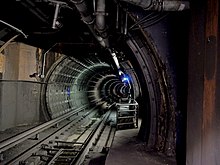 View into a bored tunnel towards the direction of the Transbay Tube | |
| Overview | |
|---|---|
| Line | |
| Location | San Francisco Bay, California, US |
| Coordinates | Oakland portal: 37°48′32″N 122°18′58″W / 37.80889°N 122.31611°W |
| System | Bay Area Rapid Transit |
| Start | Embarcadero station, San Francisco |
| End | West Oakland station, Oakland |
| Operation | |
| Opened | September 16, 1974[1] |
| Owner | San Francisco Bay Area Rapid Transit District |
| Character | Rapid transit |
| Technical | |
| Line length | 3.6 mi (5.8 km) |
| No. of tracks | 2 |
| Track gauge | 5 ft 6 in (1,676 mm) |
| Electrified | Third rail, 1 kV DC |
| Operating speed | 80 mph (129 km/h) |
| Highest elevation | Sea level |
| Lowest elevation | 135 ft (41 m) below sea level |
The Transbay Tube is an underwater rail tunnel that carries Bay Area Rapid Transit's four transbay lines under San Francisco Bay between the cities of San Francisco and Oakland in California. The tube is 3.6 miles (5.8 km) long, and attaches to twin bored tunnels.[2] The section of rail between the nearest stations (one of which is underground) totals 6 miles (10 km) in length. The tube has a maximum depth of 135 feet (41 m) below sea level.
Built using the immersed tube technique, the Transbay tube was constructed on land in 57 sections, transported to the site, and then submerged and fastened to the bottom – primarily by packing its sides with sand and gravel.[3]
Opened in 1974, the tunnel was the final segment of the original BART system to open.[4] All BART lines except the Orange Line operate through the Transbay Tube, making it one of the busiest sections of the system in terms of passenger and train traffic. During peak commute times, over 28,000 passengers per hour travel through the tunnel[5] with headways as short as 2.5 minutes.[6] BART trains can reach their highest speeds in the tube, up to 80 miles per hour (129 km/h), although trains typically operate at 70 miles per hour (113 km/h) unless trying to recover from a delay.[7]
- ^ "BART Tube Link Opens". Pittsburgh Post-Gazette. AP. September 17, 1974. Retrieved August 20, 2016.
- ^ "BART Transbay Tube & Transition Structure | SC Solutions". www.scsolutions.com. Retrieved November 15, 2021.
- ^ "A History of BART: The Project Begins | bart.gov". www.bart.gov. Retrieved November 15, 2021.
- ^ Strand, Robert (September 14, 1974). "San Francisco gets its space age underwater trains". The Dispatch. UPI. Retrieved August 20, 2016.
- ^ "The Case for a Second Transbay Transit Crossing" (PDF). Bay Area Council Economic Institute. February 2016. p. 7. Archived from the original (PDF) on April 1, 2016.
- ^ Mallett, Zakhary (September 7, 2014). "2nd Transbay Tube needed to help keep BART on track". San Francisco Chronicle.
- ^ Minton, Torri (September 17, 1984). "BART: It's not the system it set out to be". Spokane Chronicle. AP. Retrieved August 20, 2016.
Hitting speeds close to 80 mph only in the 3.6-mile tube under the bay, the trains average 36 mph for safety reasons, [BART spokesman Sy] Mouber said.
